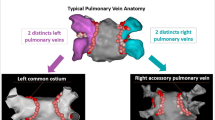Abstract
Purpose
Our aim was to elucidate the relationship between obstructive sleep apnea (OSA) and atrial fibrillation (AF) recurrence after repeated pulmonary vein isolation (PVI).
Methods
We conducted a non-randomized observational study, with the data prospectively collected. One hundred patients (paroxysmal AF, n = 89) underwent PVI using a contact force–sensing catheter. All patients underwent an electrophysiological study and additional ablation for left atrium-pulmonary vein (PV) reconnection and non-PV foci, 6 months after the first treatment session, regardless of AF recurrence. Those with an apnea-hypopnea index ≥ 15 were diagnosed with OSA. Continuous positive air pressure (CPAP) therapy was initiated after the second treatment session, based on results of a sleep study. For analysis, patients were classified into the non-OSA (n = 66), treated OSA (OSA patients undergoing CPAP; n = 11), and untreated OSA (n = 23) groups, and between-group differences evaluated.
Results
After the first session, AF recurrence was observed in 18.2% (12/66) and 14.7% (5/34) of patients without and with OSA, respectively (P = 0.678). After the second procedure, the rate of AF recurrence was 12.1% (8/66) in the non-OSA group, 9.1% (1/11) in the treated OSA group, and 8.7% (2/23) in the untreated OSA group (log-rank P = 0.944).
Conclusions
The rate of AF recurrence might not be greater in patients with untreated OSA than in those without OSA and those with treated OSA after repeated PVI, using a contact force–sensing catheter, for patients with paroxysmal or short-term persistent AF.


Similar content being viewed by others
References
Shahar E, Whitney CW, Redline S, Lee ET, Newman AB, Nieto FJ, et al. Sleep-disordered breathing and cardiovascular disease: cross-sectional results of the sleep heart health study. Am J Respir Crit Care Med. 2001;163:19–25.
Gami AS, Hodge DO, Herges RM, Olson EJ, Nykodym J, Kara T, et al. Obstructive sleep apnea, obesity, and the risk of incident atrial fibrillation. J Am Coll Cardiol. 2007;49:565–71.
Jongnarangsin K, Chugh A, Good E, Mukeriji S, Dey S, Crawford T, et al. Body mass index, obstructive sleep apnea, and outcomes of catheter ablation of atrial fibrillation. J Cardiovasc Electrophysiol. 2008;19:668–72.
Neilan TG, Farhad H, Dodson JA, Shah RV, Abbasi SA, Bakker JP, et al. Effect of sleep apnea and continuous positive airway pressure on cardiac structure and recurrence of atrial fibrillation. J Am Heart Assoc. 2013;2:e000421.
Patel D, Mohanty P, Di Biase L, Shaheen M, Lewis WR, Quan K, et al. Safety and efficacy of pulmonary vein antral isolation in patients with obstructive sleep apnea: the impact of continuous positive airway pressure. Circ Arrhythm Electrophysiol. 2010;3:445–51.
Naruse Y, Tada H, Satoh M, Yanagihara M, Tsuneoka H, Hirata T, et al. Concomitant obstructive sleep apnea increases the recurrence of atrial fibrillation following radiofrequency catheter ablation of atrial fibrillation: clinical impact of continuous positive airway pressure therapy. Heart Rhythm. 2013;10:331–7.
Fein AS, Shvilkin A, Shah D, Haffajee CI, Das S, Kumar K, et al. Treatment of obstructive sleep apnea reduces the risk of atrial fibrillation recurrence after catheter ablation. J Am Coll Cardiol. 2013;62:300–5.
Linz D, McEvoy RD, Cowie MR, Somers VK, Nattel S, Kalman JM, et al. Association of obstructive sleep apnea with atrial fibrillation and continuous positive airway pressure treatment: a review. JAMA Cardiol. 2018;3:532–40.
Ouyang F, Tilz R, Chun J, Schmidt B, Wissner E, Zerm T, et al. Long-term results of catheter ablation in paroxysmal atrial fibrillation: lessons from a 5-year follow-up. Circulation. 2010;122:2368–77.
Takigawa M, Takahashi A, Kuwahara T, Okubo K, Takahasi Y, Watari Y, et al. Long-term follow-up after catheter ablation of paroxysmal atrial fibrillation: the incidence of recurrence and progression of atrial fibrillation. Circ Arrhythm Electrophysiol. 2014;7:267–73.
Lin H, Chen YH, Hou JW, Lu ZY, **ang Y, Li YG. Role of contact force-guided radiofrequency catheter ablation for treatment of atrial fibrillation: a systematic review and meta-analysis. J Cardiovasc Electrophysiol. 2017;28:994–1005.
Nalliah CJ, Sanders P, Kalman JM. Obstructive sleep apnea treatment and atrial fibrillation: a need for definitive evidence. J Cardiovasc Electrophysiol. 2016;27:1001–10.
Dimitri H, Ng M, Brooks AG, Kuklik P, Stile MK, Lau DH, et al. Atrial remodeling in obstructive sleep apnea: implications for atrial fibrillation. Heart Rhythm. 2012;9:321–7.
Maeno K, Kasagi S, Ueda A, Kawana F, Ishiwata S, Ohno M, et al. Effects of obstructive sleep apnea and its treatment on signal-averaged p-wave duration in men. Circ Arrhythm Electrophysiol. 2013;6:287–93.
Anter E, Di Biase L, Contrerasvaldes F, Mohanty S, Tchanbrunn C, et al. Atrial substrate and triggers of paroxysmal atrial fibrillation in patient with obstructive sleep apnea. Circ Arrhythm Electrophysiol. 2017;10:e005407.
Makimoto H, Tilz R, Lin T, Rillig A, Mathew S, Deiss S, et al. Incidence and anatomical locations of catheter instability during circumferential pulmonary vein isolation using contact force. Int Heart J. 2014;55:249–55.
Kang KW, Kim TH, Park J, Uhm JS, Joung B, Hwang C, et al. Long-term changes in heart rate variability after radiofrequency catheter ablation for atrial fibrillation: 1-year follow-up study with irrigation tip catheter. J Cardiovasc Electrophysiol. 2014;25:693–700.
McEvoy RD, Antic NA, Heeley E, Luo Y, Ou Q, Zhang X, et al. CPAP for prevention of cardiovascular events in obstructive sleep apnea. N Engl J Med. 2016;375:919–31.
Author information
Authors and Affiliations
Contributions
Rintaro Hojo designed the study and wrote the initial draft of the manuscript. Seiji Fukamizu and Masayasu Hiraoka contributed to analysis and interpretation of data. All other authors have contributed to data collection and interpretation and critically reviewed the manuscript.
Corresponding author
Ethics declarations
Conflict of interest
The authors declare that they have no conflict of interest.
Rights and permissions
About this article
Cite this article
Hojo, R., Fukamizu, S., Miyazawa, S. et al. The relationship between obstructive sleep apnea and recurrence of atrial fibrillation after pulmonary vein isolation using a contact force–sensing catheter. J Interv Card Electrophysiol 54, 209–215 (2019). https://doi.org/10.1007/s10840-018-0489-x
Received:
Accepted:
Published:
Issue Date:
DOI: https://doi.org/10.1007/s10840-018-0489-x




